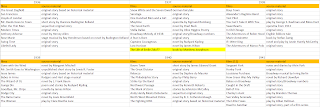One of the most celebrated of Swedish filmmakers is undoubtedly Jan Troell, who today turns 90. He is still active, re-cutting one of his films, Bang! (1977), for a re-release, and participating in exhibitions and retrospectives, at home and abroad, about his work and art.
His first feature-length film, after years of making short films, is Here is Your Life/Här har du ditt liv (1966). It is set in the far north of Sweden during the years of World War 1 and focuses on a young man, a boy at first, who leaves home to travel around the country looking for jobs, discovering sex and socialism, and finally getting a job as a projectionist at a cinema. There he eventually sees newsreel footage that the war is over, and he quits, finally buys that hat he has been wanting for so long, and leaves, potentially heading for Paris.
It was probably the longest Swedish film made up until that point, over 160 minutes, and it is certainly among the most beautiful. Troell's cinematography, primarily black and white but at times in colour, and with some sequences even animated, captures the far north like few, if any, other Swedish films, both the deep snow in winter and the short and ethereal summer. He mixes all kinds of techniques, as if thrilled by the amazing possibilities of the camera and the editing board, and not wanting to leave anything out. And every character is played to perfection by many of Sweden's best actors, often in small parts. I particularly like Ulf Palme as a foreman at a sawmill and Gunnar Björnstrand as the owner of the cinema. The film is an endless source of pleasure, including Eddie Axberg in the lead role.
Troell is his own editor and cinematographer (from the late 1990s together with Mischa Gavrjusjov), and his style is impressive. A combination of raw realism, lyrical interludes, and expressionistic touches, and where the natural world plays an important part; trees, grass, insects, water given as much attention as the characters. The narrative often consists of vignettes and sketch-like scenes, capturing a mood or a significant moment, without necessarily highlighting its importance. In that regard many scenes do not forward the story in a conventional sense but work together to create an impression, or impressions, of the main character. This main character, as so often in Troell's films, is a person who is a dreamer and seeker, who wants to unleash him- or herself from a quotidian existence, and they are often people from Swedish history, real historical figures. Because another theme of Troell is Sweden itself, its past and its present.
All of the above is present in Here Is Your Life, and they would remain central aspects of his later films, even though not necessarily all at once. Some other films by Troell to mention are the nightmarish Who Saw Him Die/Ole dole doff (1968), about a primary school teacher (as Troell had been); the epics The Emigrants/Utvandrarna (1971) and The New Land/Nybyggarna (1972), about Swedes emigrating to the U.S. in the mid-19th century; Flight of the Eagle/Ingenjör Andrées luftfärd (1982), about a failed expedition by balloon to the North Pole in 1897; the documentary Land of Dreams/Sagolandet (1988), Hamsun (1996), about the Norwegian writer who during World War 2 embraced the Nazis; As White as in Snow/Så vit som en snö (2001), about the Swedish aviation pioneer Elsa Andersson; and Everlasting Moments/Maria Larssons eviga ögonblick (2008), about a hard-working woman with a brutal husband who finds solace in photography during the 1910s. The everlasting moments are the images that she captures with her camera, and in that she is a kindred spirit of Troell.
But this post is not meant to be a critical evaluation of Troell's oeuvre, in all its strengths and weaknesses, but a celebration of a remarkable filmmaker on his 90th birthday!



